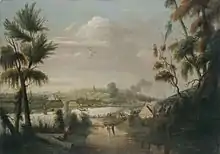Thomas Watling
Thomas Watling (19 September 1762 – 1814?), was an early Australian painter and illustrator, notable for his natural history drawings and landscapes.[1]
Thomas Watling | |
|---|---|
 A Direct North View of Sydney Cove, 1794 by Thomas Watling | |
| Born | 19 September 1762 Dumfries, Scotland |
| Died | 1814? |
| Occupation(s) | Landscape and natural history artist, author and convict |
| Parent |
|
Early life and education
Born in Dumfries, Scotland, he was raised by his maiden aunt, Marion Kirkpatrick, after both parents died in his infancy. Art featured in his education and he went on to form his own “academy” where he taught drawing to "Ladies and Gentlemen".[2] In Glasgow he worked briefly as a coach and chaise painter before being charged with forgery, in Dumfries on 27 November 1788.[1]
Conviction and transportation to New South Wales
Watling was charged with having forged 1 guinea promissory notes of the Bank of Scotland, and sentenced to fourteen years' transportation to New South Wales on 14 April 1789. He was held at Plymouth in the prison ship Dunkirk, before being transferred to the convict transport Pitt. [2] Departing on the Pitt with 410 convicts in July 1791, Watling escaped while docked at Cape Town.[1] He was later arrested and transferred to the East Indiaman Royal Admiral, finally arriving in Sydney on 7 October 1792.[1]
Career
Artist in New South Wales
Thomas Watling is thought to be the first professional artist to arrive in New South Wales.[3]
In Sydney Watling worked with John White, the colony's Surgeon General, copying natural history illustrations. In 1796 he was given a conditional pardon by the colony's second governor, John Hunter, made absolute on 5 April 1797.[1]
Thomas Watling painted many of the early colonial pictures of Australia and made a prolific number of sketches of birds, fish, mammals, plants, landscapes and Aboriginal people.[3][1]
One painting that was attributed to him, A direct north general view of Sydney Cove 1794, is the earliest known oil painting of Sydney.[3] The identity of the artist of this oil painting has long been debated. The inscription on the reverse clearly identifies Watling, however, he is not known to have painted in oils. The canvas is dated 1794 and there is no record of any colonial artist using oils until 1812, by which time Watling had received a pardon and returned to Britain.[3] It is now believed this work was painted in Britain, possibly based on sketches made by Watling in Sydney.[4][1] This work now belongs to the Dixson Gallery, State Library of New South Wales.[5][4]
References
- Rienits, Rex. "Watling, Thomas (1762–?)". Thomas Watling (1762-?). Retrieved 1 February 2018.
{{cite book}}:|website=ignored (help) - Bull, Gordon. "Thomas Watling b. 1762". Design & Art Australia Online. Retrieved 2 February 2018.
- Farthing, Stephen, ed. (2011). "1001 paintings you must see before you die". State Library of New South Wales Catalogue. ABC Books. Retrieved 2 February 2018.
- Watling, Thomas (1794). "A direct north general view of Sydney Cove". Manuscripts, Oral History and Pictures Catalogue, State Library of New South Wales. Retrieved 2 February 2018.
- McCormick, Tim (1987). First views of Australia: a history of early Australia. Chippendale, NSW: David Ell Press in association with Longueville Publications. ISBN 0908197721.
Further reading
- Hindwood, K.A. (1970). "The "Watling" drawings with incidental notes on the "Lambert" and the "Latham" drawings". Proceedings of the Royal Zoological Society of New South Wales. 89 (1968–1969): 16–32.
- Watling, Thomas (1794). Letters From An Exile At Botany Bay, To His Aunt In Dumfries: giving a particular account of the settlement of New South Wales, with the customs and manners of the inhabitants (PDF). Penrith, Scotland: Ann Bell. OCLC 225347415.
External links
- Watling,Thomas (1762–?) Australian Dictionary of Biography
- "The Watling Collection". London: Natural History Museum.